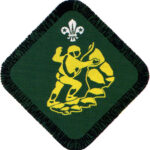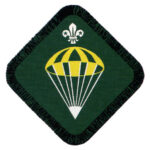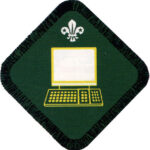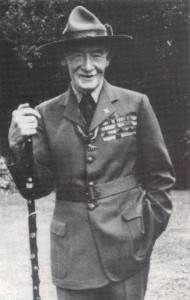
Embracing the new millennium with renewed confidence, the World Scout Movement will celebrate its centenary in 2007.
The World Scout Movement started in England with an experimental camp on Brownsea Island, Dorset, in 1907, where Robert Baden-Powell and a small party of boys put into practice his ideas for training young people for responsible citizenship. In August of the following year, the first proper Scout Camp was held at Humshaugh, near Hexham, Northumberland.
Robert Baden-Powell was 50 when the Brownsea Camp took place, and his many experiences as a boy and soldier certainly played a part in the formulation of his training methods. As a boy – one of six brothers – he used to spend his holidays camping, hiking and sailing. Tent-pitching, using map and compass and cooking over a wood fire were but a few of the skills he acquired. At Charterhouse School he used to visit a favourite, but out of bounds, copse, where he learned how to hide his tracks, climb a tree and ‘freeze’ to escape attention – an important factor if any of the schoolmasters entered the wood.
In 1877 he went to India as a young Army officer, and specialised in scouting, map-making and reporting. Success in this led to his training young soldiers for the work. B-P.’s methods were unorthodox for those days, and in them it is possible to see the forerunners of his principles for training youth – small units of Patrols working together under one leader, and special distinction for those who did well. For particular efficiency, B-P awarded his trainee scouts a badge based on the north compass point, and today’s Scout Badge is very similar.
Robert Baden-Powell’s fame as an Army scout grew, and by the time he went to Africa – Ashanti and Matabeleland – he took to wearing a wide-brimmed hat for protection against the sun and rain, and one of the details he noticed, an army engineer carrying a pole marked in feet and inches, was later to re-appear as the Boy Scout staff.
Secret Service work in the Balkans, followed by a return to Africa and the successful defence of Mafeking during its 217-day siege at the start of the South
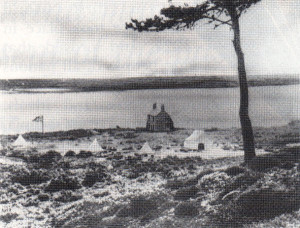
African War, provided fresh opportunities for B-P to apply his scouting skills. The courage and resourcefulness shown by the boys who were formed into corps of messengers at Mafeking made a lasting impression on him, and in turn B-P’s deeds had made a lasting impression on the boys of England.
When he returned home he found he’d become a national hero. In addition, a small handbook for soldiers which he’d written was being used to teach observation and woodcraft to members of boys’ clubs and the Boys’ Brigade. B-P decided to rewrite the book for use by boys, and the camp on Brownsea Island was planned to test his ideas in practice.
The success of Scouting for Boys produced a movement that quickly – automatically, it seemed – adopted the name The Boy Scouts and necessitated the establishment of an office to administer it.
By 1909, the movement had taken firm root. Scouting for Boys had been translated into five languages. Sea Scouts had been formed, and B-P’s eldest brother, Warrington, himself an ex-sailor, wrote the official handbook for them.
As a result of B-P taking a South American holiday, one of the first countries outside Britain to adopt Scouting was Chile.
An idea of how things were moving was given by the Scout Rally at Crystal Palace in London in September 1909. More than 11,000 Scouts attended.
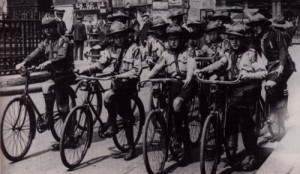
Success brought a major problem, though. B-P had to decide whether his future lay with the Army or his newly-formed Boy Scouts. A journey to Balmoral Castle, where he received the honour of Knight Commander of the Royal Victorian Order, and discussion with King Edward on the future of the movement, provided the answer. In the years that followed, Scouting spread to more and more countries. In 1910,
B-P visited Canada and the United States, where it was already flourishing. Later came visits to all parts of the world.
A spectacular rally of over 26,000 boys in Windsor Great Park in 1911 provided
another milestone. The Scouts gave tumultuous applause for their King and Queen and to their beloved Chief.
In 1912, the movement was granted its Royal Charter, and King George V became its Patron.
The coming of war in 1914 could have brought about the collapse of the movement, but the training provided through the patrol system proved its worth and patrol leaders took over when adult Leaders volunteered for active service. Scouts contributed to the war effort in many ways; most notable perhaps being the Sea Scouts, who took the place of regular coast guards, so freeing them for service afloat.
The first World Jamboree took place in 1920, and proved that young people of all nations could come together to share common interests and ideals. Since that first Jamboree at Olympia, London, there have beenl8 others.
The success of Scouting with boys from 11 to 18 years gave rise to appeals to provide a similar activity for younger boys and so, in 1916, the Wolf Cub Section for 8 to 11-year-olds was formed. Kipling’s Jungle Books were used to provide an imaginative background to the activities and, by the end of the year, more than 10,000 boys had enrolled.
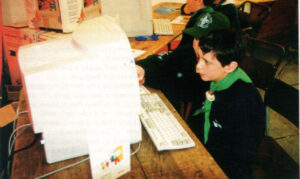


In 1918, the Rover Scout Branch was started, to cater for young men over 18 years of age; 1941 saw the introduction of the Air Scout Branch. Senior Scouts – a section specially for the 15 to 18 age group – started in 1946.
Between the two wars, Scouting continued to flourish in all parts of the
world, except in totalitarian countries where it was banned. Scouting is essentially democratic and voluntary. When war came in 1939, the story of 1914 was repeated. Scouts carried on under the patrol leaders, undertaking many National Service tasks – messengers, fire-watchers, stretcher-bearers, salvage collection and so on. In occupied countries, Scouting carried on in secret with Scouts playing important roles in the resistance and underground movements. After the liberation, it was found that the numbers of Scouts in some occupied countries had, in fact, increased. Today, there are more Scouts than ever before – about 25 million in nearly 150 countries.
As B-P was always quick to emphasise, Scouting is a movement and, as such, is not able to remain static. Hence, in 1966, an Advance Party Report, prepared as a working document incorporating the voices of leading figures in industry and youth work, as well as the suggestions of some 25,000 Members of the Movement, gave the direction of the future. Its recommendations for more sophisticated training programmes and activities appropriate to the times led to the broadening of training programmes and an up-to-date appeal to modern boys and, indeed, as ofjune 1991, modern girls too.
In 1967, The Scout Association abandoned short trousers and big hats and introduced a whole range of new methods designed for boys, girls, young men and women in a technological age. Today’s Scouts take part in a wide range of adventurous and challenging activities, with opportunities for parachuting, caving, mountaineering, sailing and canoeing, as well as their long-standing camping activities. They are also able to learn about computers and the Internet, enabling them to be truly modern citizens.
The Association continues to grow and evolve, like its members. Some of the old badges, such as Blacksmith and Miner, have given way to the Information Technology and Circus Skills badges. All this is to ensure that young people remain interested in Scouting – and it seems to work. Indeed, there are many areas of Britain where there are waiting lists of young people wanting to join.
As Scouting enters the 21st Century, the Movement has much to look forward to. In 2007, it celebrates 100 years of Scouting. To commemorate this important event, Britain has been chosen to host the Centennial World Scout Jamboree. The Scout Association has already begun to plan for this exciting project which will attract 35,000 Scouts from around the world and see Scouting enter a new age.



